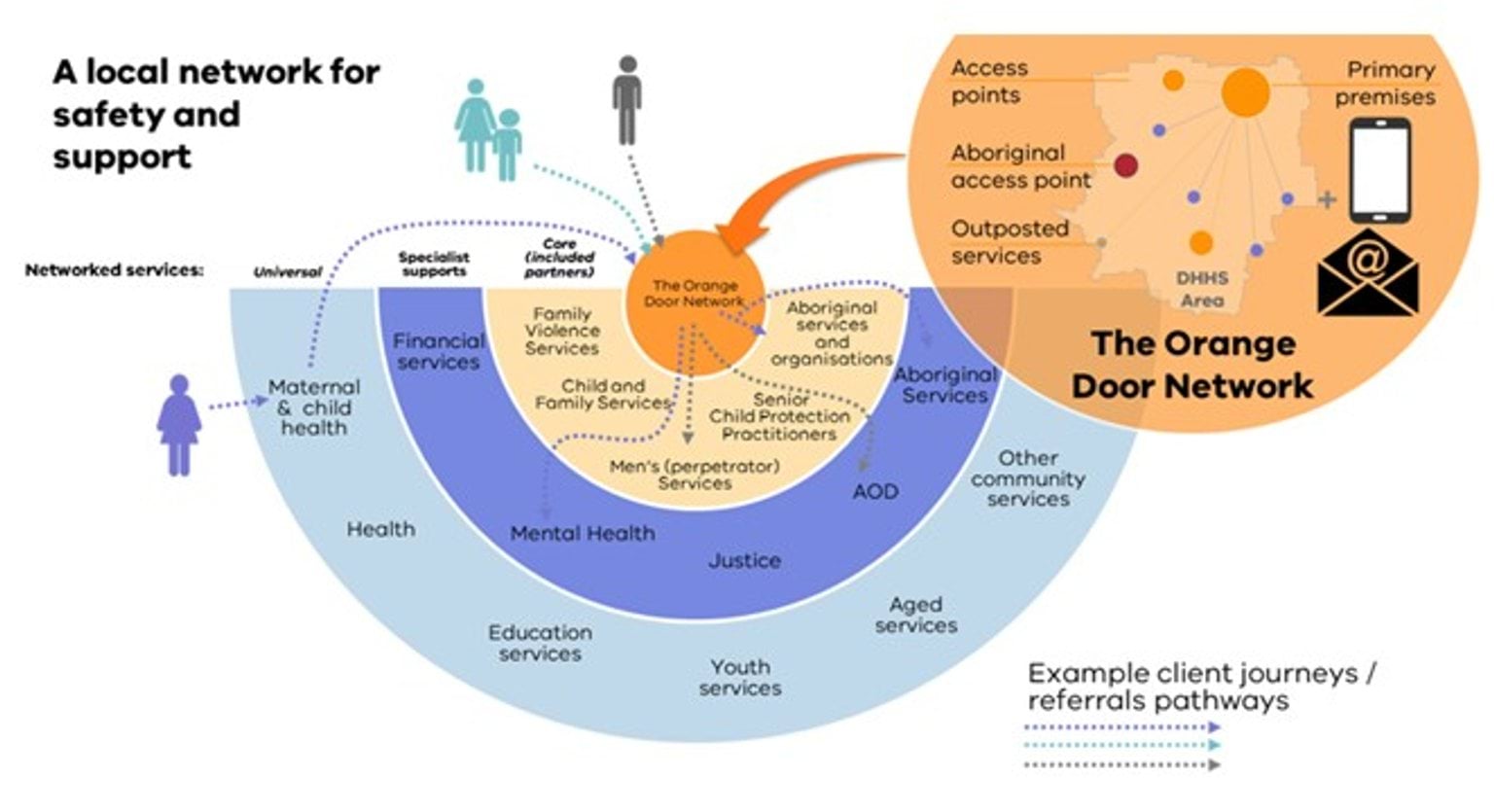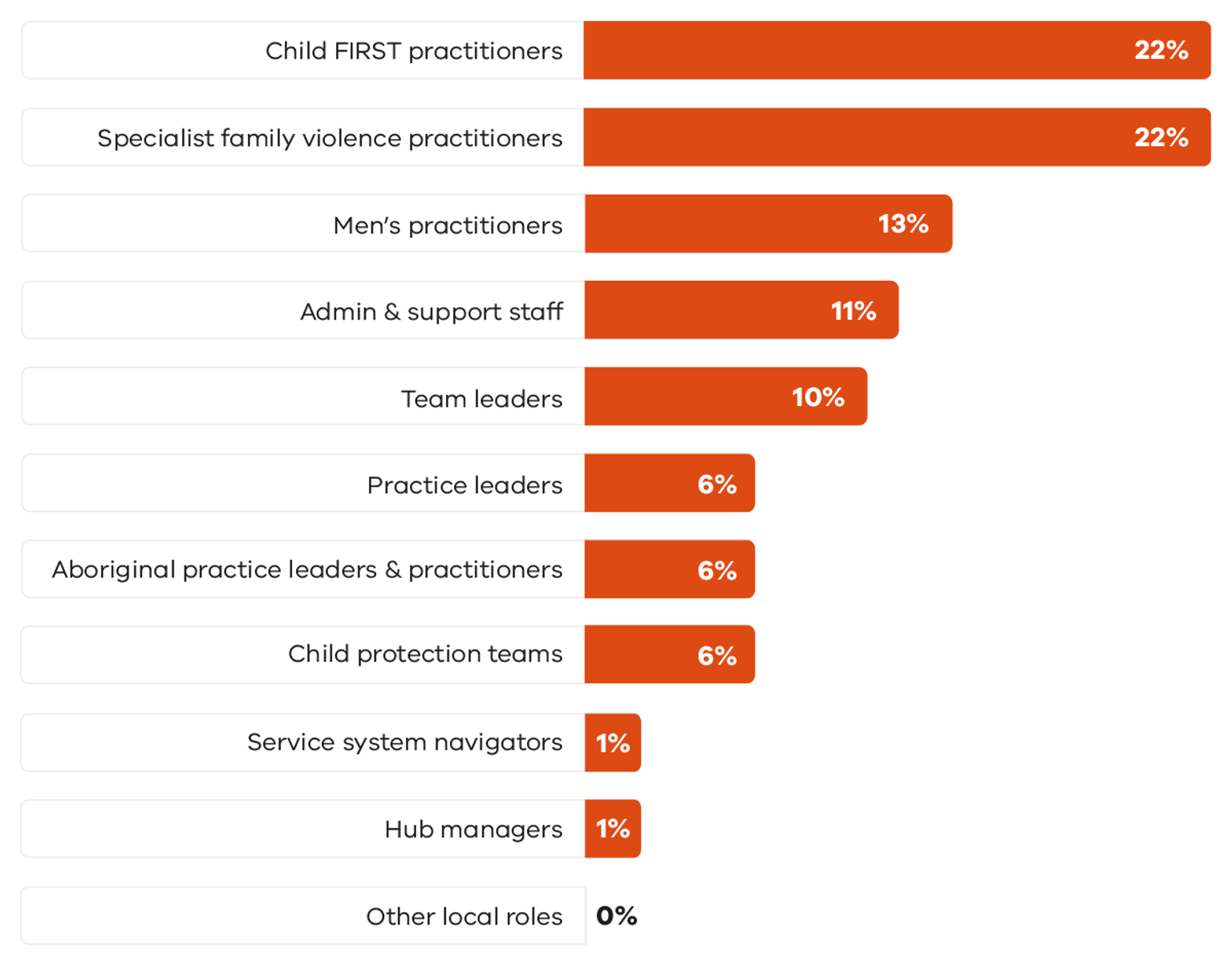What is The Orange Door network and how does it work?
The Orange Door network is for children, young people and adults who are at risk of experiencing or have experienced family violence, and for families who require support with the development and wellbeing needs of their children and young people. It assesses and responds to a person’s needs and risk, and connects people to family violence services, Aboriginal Community Controlled Organisations (ACCO), family services, and services for perpetrators (collectively referred to as ‘core services’).[6]
The Orange Door is also for perpetrators of family violence, engaging to hold them accountable for their choice to use family violence and provide services to assist them to address their use of violence. The Orange Door works with the wider service system, such as courts and corrections, to plan interventions to address the risks they pose.
The Orange Door keeps the whole family in view and provides a more visible contact point to access family violence services, family services and perpetrators services, with expert support tailored to each family member’s needs.
The Orange Door network also connects people to a broader range of services such as mental health or housing support. Practitioners support people to navigate the service system and address the spectrum of needs that might be identified. By providing an integrated service response, The Orange Door network is designed to avoid the person having to ‘re-tell their story’.
How The Orange Door network is set up to support people
The Orange Door network provides a visible entry point in each The Orange Door area for children, young people and adults who are at risk of experiencing or have experienced family violence, and those using family violence. It also provides an entry point for families who need support with the development and wellbeing needs of their children and young people.
Practitioners work in interdisciplinary teams to ensure the required specialisations can respond to the person/family, while working together to provide an integrated assessment of risk and needs (Figure 3).
The Orange Door network facilitates strong connections into local community services to support clients getting the help they need from other services. This includes working in partnership with local Aboriginal services, organisations and communities to support Aboriginal self-determination and ensure that culturally safe responses are available for Aboriginal people.
The Orange Door network provides a range of options to support people seeking assistance close to home. This is made possible by complementing the primary site with access points, outpost sites and providing outreach, in addition to the primary site.
Access networks are vital in providing accessible services for clients and communities across Victoria. The Orange Door network is working to establish access points and outposts across the state. The Orange Door network walk-in services are in Bacchus Marsh, Bairnsdale, Ballarat, Bendigo, Box Hill, Broadmeadows, Coburg, Colac, Croydon, Dandenong, Epping, Frankston, Geelong, Hastings, Heidelberg, Leongatha, Maryborough, Mildura, Morwell, Pakenham, Prahran, Shepparton, Sunbury, Swan Hill, Wallan, Wangaratta, Warragul, Warrnambool and Wodonga.
The Orange Door network offers face-to-face, telephone and email support, ensuring there are multiple ways to access help and support across the area. Access planning to increase the number of walk-in and appointment-based locations is underway across the state.
Led by the Aboriginal Strategy Unit, the Aboriginal Access Point Services Implementation Project is informed by the Royal Commission into Family Violence findings, the current Victorian Aboriginal family violence policy context and is guided by the Aboriginal Access Point Services Model endorsed by the Dhelk Dja Koori Caucus in May 2021.
These services will deliver a community-led service model that is self-determined by Victorian Aboriginal peoples and delivered by local ACCOs as a culturally safe and culturally responsive family violence service that place Aboriginal women, children and families first. The service focus is on healing and early intervention, with Elders and respected community members providing cultural support and response, as well as fostering strong partnerships with agencies across the state.
They will be complemented by the service offerings of The Orange Door network and will work closely with The Orange Door Aboriginal Practice Leaders to ensure appropriate referrals for clients to relevant services.
Who works at The Orange Door network?
The Orange Door network workforce is comprised of staff from community services, health services and ACCOs with specialisations in family violence and/or child and family services. In addition, the Community Based Child Protection team is part of The Orange Door workforce, in conjunction with a team of staff employed by FSV.
The workforce includes:
- Specialist Practitioners: The expertise of different practitioners is drawn on to provide an interdisciplinary approach with specialists in family violence, child and family services, ACCOs and perpetrator services working together in The Orange Door network.
- Practice leadership: practice leadership is provided to the practitioners to support high quality and culturally safe service delivery through practice leadership roles such as: Team Leader, Aboriginal Practice Leader, Advanced Family Violence Practice Leader, Integrated Practice Leader, Children and Young People’s Practice Leader, Advanced Family Violence (Men’s) Practice Leader and Community Based Senior Child Protection Practitioners.
- Operational support: The Orange Door network teams are supported by a team from FSV that includes a Manager, Service System Navigator, Strategic Planning and Reporting Officer, Operational Support Officers, Client Support Officers and administrative support staff.
The total funded workforce for 15 The Orange Door areas operational at 30 June 2022 was just over 1,100 Full Time Equivalent (FTE) positions and comprised a range of different roles (Figure 4). Of those, 183 FTE positions were vacant at that point.
The Orange Door staffing profile faces similar workforce issues to the broader community services workforce, including Family Violence, Child and Family services and ACCOs who all experienced significant workforce shortages.
FSV continues to work collaboratively with peak bodies and service partners to strengthen workforce capability in culturally responsive, skilled and integrated practice, including the commencement of Aboriginal cultural safety training to all staff, and a new induction and learning program. The Orange Door Aboriginal Inclusion Action Plan plays an important role in this. This aims to build workforce capability with a view to providing services that are culturally safe and accessible for Aboriginal people.
Notes
[6] The Orange Door network provides a range of responses to individuals and families referred through for support, from the assessment of risk and need, development of safety plans, provision of an immediate crisis response, access to brokerage and connection to other services for ongoing support such as family violence case management and family services. The Orange Door network, What is the Orange Door webpage, State Government of Victoria, accessed 7 November 2022.
Updated

